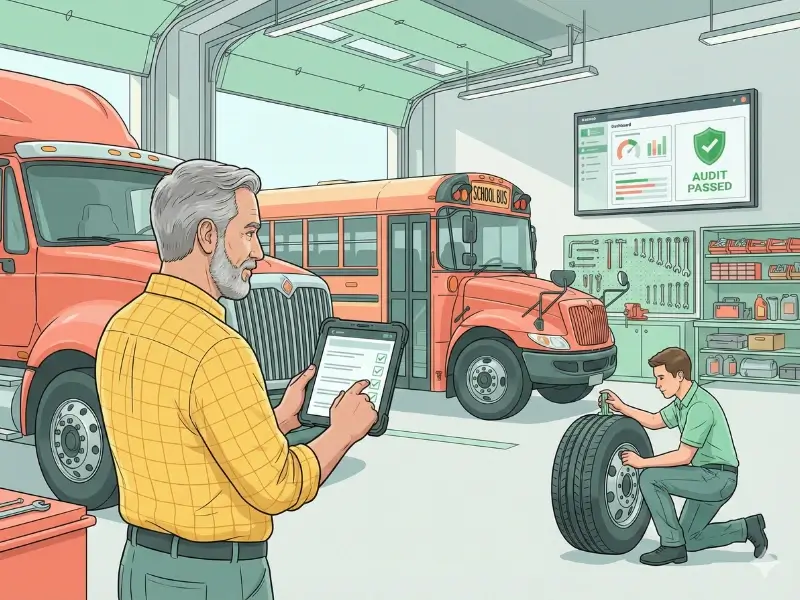Key Takeaways
Garbage trucks are an essential part of keeping our communities clean and healthy. However, to ensure that these trucks operate safely and efficiently, regular inspections are crucial.
A comprehensive garbage truck inspection checklist helps in maintaining the vehicle, preventing accidents, and ensuring smooth operation. In this article, we'll discuss the key items that should be included in a garbage truck inspection checklist, making it easy to understand for everyone.
What are Garbage Trucks?
Garbage trucks are complex vehicles that perform heavy-duty tasks every day. Due to their constant use and exposure to different types of waste, they require regular maintenance and inspections.
A garbage truck inspection checklist is a tool used by waste management professionals to assess the condition, safety, and functionality of these trucks. Regular inspections help identify potential issues before they become serious problems, ensuring that the trucks are always in good working order.
Why is a Garbage Truck Inspection Checklist Important?
There are several reasons why a garbage truck inspection checklist is important:
- Safety: Regular vehicle inspections help identify potential safety hazards before they lead to accidents.
- Compliance: Many areas require periodic vehicle inspections to ensure they meet safety and environmental regulations.
- Efficiency: Well-maintained trucks operate more efficiently, reducing fuel consumption and downtime.
- Cost Savings: Early detection of issues can prevent costly repairs and extend the vehicle's lifespan.
- Environmental Protection: Proper maintenance ensures that garbage trucks don't leak harmful substances into the environment.
Key Items for Your Garbage Truck Inspection Checklist
A well-structured inspection checklist helps identify potential issues early, preventing costly repairs and ensuring smooth operations. Here are the key items that should be included in your garbage truck inspection checklist.
1. Hydraulic Systems
The hydraulic system is the heart of a garbage truck's lifting and compacting mechanisms. A failure in this system can lead to serious safety hazards and operational
downtime. Here’s what to check:
- Fluid Levels: Ensure hydraulic fluid levels are adequate.
- Leaks: Look for any signs of leaks in the hydraulic hoses and cylinders.
- Hoses: Check hoses for wear, cracks, or bulges.
- Operation: Test the lifting and compacting mechanisms for smooth operation.
- Pressure Relief Valve: Make sure the pressure relief valve is functioning correctly.
2. Brakes and Tires
Given the frequent stops and starts in waste collection routes, the braking system and tires of a garbage truck undergo significant stress. Here's what to inspect:
- Brake Pads: Check the thickness of brake pads.
- Brake Lines: Inspect brake lines for leaks or damage.
- Brake Pedal: Test brake pedal feel and responsiveness.
- Tire Pressure: Ensure tire pressure is at the recommended level.
- Tread Depth: Check the tread depth of tires.
- Wear or Damage: Look for any signs of uneven tire wear or damage.
3. Lighting and Signaling Systems
Proper lighting is essential for safety, especially during early morning collections or in low visibility conditions. Here’s what to verify:
- Exterior Lights: Test all exterior lights, including headlights, taillights, brake lights, and turn signals.
- Reverse Lights and Alarms: Check reverse lights and backup alarms.
- Reflectors: Verify that all reflectors and reflective tape are intact and visible.
- Strobe Light: Ensure the strobe light or beacon is functioning correctly.
4. Waste Containment Systems
Proper waste containment is essential for environmental protection and compliance with regulations. Here’s what to check:
- Hopper and Body: Inspect the hopper and body for cracks or holes.
- Seals and Gaskets: Check that all seals and gaskets are intact.
- Tailgate Locks: Verify that tailgate locks are secure and functioning.
- Tailgate Sealing: Ensure the tailgate is properly sealed when closed.
5. Safety Equipment
Garbage trucks must be equipped with various safety features to protect workers and the public. Here’s what to inspect:
- Fire Extinguishers: Verify the presence and condition of fire extinguishers.
- First Aid Kits: Check first aid kits for completeness and expiration dates.
- Safety Labels: Ensure all required safety labels and decals are present and legible.
- Handholds and Steps: Inspect handholds, steps, and platforms for security and wear.
- Seatbelts: Check seatbelts for proper function and wear.
6. Engine and Drivetrain
The engine and drivetrain are critical for the overall operation of the garbage truck. Here’s what to inspect:
- Oil and Coolant Levels: Check engine oil and coolant levels.
- Belts and Hoses: Inspect belts and hoses for wear or damage.
- Unusual Noises: Listen for any unusual engine noises.
- Transmission Fluid: Check the transmission fluid level and condition.
- Fluid Leaks: Inspect for any fluid leaks under the vehicle.
7. Onboard Technology Systems
Modern garbage trucks often come equipped with various technological systems that need regular checks. Here’s what to inspect:
- Onboard Computer or Tablet: Test for proper function.
- GPS Tracking Systems: Verify that GPS tracking systems are operational.
- Cameras and Sensors: Check any cameras or sensors for cleanliness and proper operation.
- Communication Systems: Ensure that communication systems are working correctly.
Download a Free Truck Inspection Checklist
How to Implement an Effective Inspection Process
Implementing an effective inspection process for garbage trucks is essential for ensuring safety, compliance, and operational efficiency. Here’s how you can establish a robust inspection routine:
- Develop a Comprehensive Checklist: Create a detailed daily checklist for drivers that covers all important areas of the garbage truck. Make sure it is easy to understand and use.
- Train Your Team: Ensure all drivers and maintenance personnel are properly trained on how to conduct thorough inspections. Training should include how to use inspection tools and how to identify potential issues.
- Establish a Regular Schedule: Implement daily pre-trip inspections and more comprehensive weekly or monthly checks. Consistency is key to catching issues early.
- Use Digital Tools: Consider using digital inspection apps to simplify the process and maintain better records. These tools can help track inspections and remind you of upcoming maintenance.
- Follow-up on Issues: Establish a clear process for reporting and addressing any problems found during inspections. Make sure issues are fixed promptly to avoid further damage or safety hazards.
- Keep Detailed Records: Maintain a log of all inspections and repairs for each vehicle in your fleet. This documentation can help track the truck’s history and plan future maintenance.
- Review and Update: Regularly review your inspection process and update your checklist as needed based on new regulations or identified issues. Continuous improvement will ensure your inspection process remains effective.
Features of an Effective Garbage Truck Inspection Program
An effective garbage truck inspection program is essential for maintaining the safety, efficiency, and compliance of your fleet. Such a program helps in identifying potential issues early, reducing downtime, and ensuring that trucks operate at their best.
- Customizability: Tailor your checklist to your specific fleet and operational needs. Different trucks and routes may have unique requirements.
- User-Friendly: Design the checklist to be easy to understand and complete. If the checklist is too complicated, it might not be used properly.
- Comprehensive: Cover all critical systems and components of the garbage truck. Make sure nothing is overlooked.
- Time-Efficient: Balance thoroughness with practicality to ensure inspections can be completed in a reasonable timeframe. Inspections should be thorough but not so time-consuming that they disrupt operations.
- Data-driven: Use inspection data to inform maintenance schedules and fleet management decisions. Analyzing this data can help identify patterns and prevent future issues.
- Compliance-Focused: Ensure your checklist meets or exceeds all relevant regulatory requirements. Staying compliant is necessary for legal and safety reasons.
- Safety-Oriented: Prioritize items that have the most significant impact on safety. The main goal of inspections is to ensure the safety of operators and the public.
Optimize Your Fleet Maintenance with Simply Fleet Today
A well-maintained garbage truck is not just a matter of operational efficiency; it's a commitment to the safety of your workers, the public, and the environment. Regular, comprehensive inspections are your first line of defense against potential problems and a key factor in the longevity and reliability of your fleet.
Keep your fleet running smoothly with Simply Fleet's Fleet Maintenance Software. Our easy-to-use software helps you track and manage all your vehicles' maintenance needs, ensuring regular inspections, timely repairs, and detailed records. Improve efficiency, reduce downtime, and extend the life of your fleet. Start using Simply Fleet today and experience hassle-free fleet management!



.png)








.png)


.png)



.webp)




